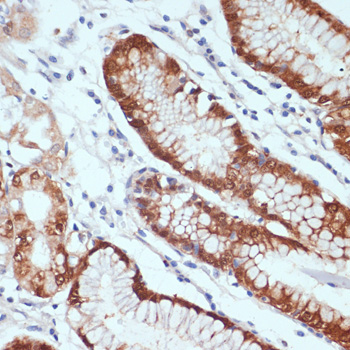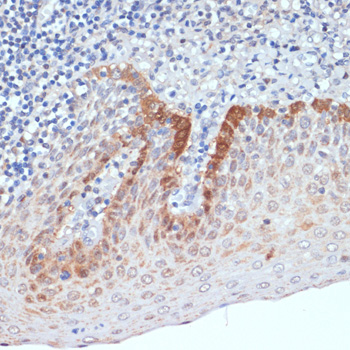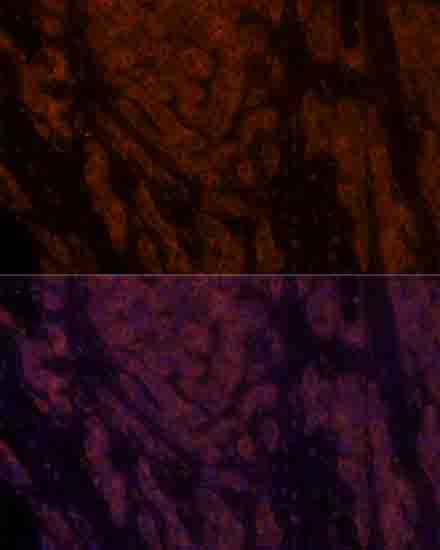Cell Biology Antibodies 3
Anti-CXCL12 Antibody (CAB1325)
- SKU:
- CAB1325
- Product Type:
- Antibody
- Reactivity:
- Human
- Reactivity:
- Mouse
- Reactivity:
- Rat
- Host Species:
- Rabbit
- Isotype:
- IgG
- Antibody Type:
- Polyclonal Antibody
- Research Area:
- Cell Biology
Description
| Antibody Name: | Anti-CXCL12 Antibody |
| Antibody SKU: | CAB1325 |
| Antibody Size: | 20uL, 50uL, 100uL |
| Application: | IHC IF |
| Reactivity: | Human, Mouse, Rat |
| Host Species: | Rabbit |
| Immunogen: | Recombinant fusion protein containing a sequence corresponding to amino acids 22-89 of human CXCL12 (NP_954637.1). |
| Application: | IHC IF |
| Recommended Dilution: | IHC 1:100 - 1:200 IF 1:100 - 1:200 |
| Reactivity: | Human, Mouse, Rat |
| Positive Samples: | NCI-H292 |
| Immunogen: | Recombinant fusion protein containing a sequence corresponding to amino acids 22-89 of human CXCL12 (NP_954637.1). |
| Purification Method: | Affinity purification |
| Storage Buffer: | Store at -20'C. Avoid freeze / thaw cycles. Buffer: PBS with 0.02% sodium azide, 50% glycerol, pH7.3. |
| Isotype: | IgG |
| Sequence: | KPVS LSYR CPCR FFES HVAR ANVK HLKI LNTP NCAL QIVA RLKN NNRQ VCID PKLK WIQE YLEK ALNK |
| Gene ID: | 6387 |
| Uniprot: | P48061 |
| Cellular Location: | Secreted |
| Calculated MW: | 10kDa/11kDa/13kDa/15kDa |
| Observed MW: | 18kDa |
| Synonyms: | CXCL12, IRH, PBSF, SCYB12, SDF1, TLSF, TPAR1 |
| Background: | This antimicrobial gene encodes a stromal cell-derived alpha chemokine member of the intercrine family. The encoded protein functions as the ligand for the G-protein coupled receptor, chemokine (C-X-C motif) receptor 4, and plays a role in many diverse cellular functions, including embryogenesis, immune surveillance, inflammation response, tissue homeostasis, and tumor growth and metastasis. Mutations in this gene are associated with resistance to human immunodeficiency virus type 1 infections. Multiple transcript variants encoding different isoforms have been found for this gene. |
| UniProt Protein Function: | Function: Chemoattractant active on T-lymphocytes, monocytes, but not neutrophils. Activates the C-X-C chemokine receptor CXCR4 to induce a rapid and transient rise in the level of intracellular calcium ions and chemotaxis. Also binds to another C-X-C chemokine receptor CXCR7, which activates the beta-arrestin pathway and acts as a scavenger receptor for SDF-1. SDF-1-beta(3-72) and SDF-1-alpha(3-67) show a reduced chemotactic activity. Binding to cell surface proteoglycans seems to inhibit formation of SDF-1-alpha(3-67) and thus to preserve activity on local sites. Acts as a positive regulator of monocyte migration and a negative regulator of monocyte adhesion via the LYN kinase. Stimulates migration of monocytes and T-lymphocytes through its receptors, CXCR4 and CXCR7, and decreases monocyte adherence to surfaces coated with ICAM-1, a ligand for beta-2 integrins. SDF1A/CXCR4 signaling axis inhibits beta-2 integrin LFA-1 mediated adhesion of monocytes to ICAM-1 through LYN kinase. Inhibits CXCR4-mediated infection by T-cell line-adapted HIV-1. Plays a protective role after myocardial infarction. Induces down-regulation and internalization of CXCR7 expressed in various cells. Has several critical functions during embryonic development; required for B-cell lymphopoiesis, myelopoiesis in bone marrow and heart ventricular septum formation. Ref.13 Ref.16 Ref.17 Ref.19 Ref.22 Ref.23 |
| UniProt Protein Details: | Subunit structure: Monomer or homodimer; in equilibrium. Dimer formation is induced by non acidic pH and the presence of multivalent anions, and by binding to CXCR4 or heparin. Monomeric form is required for full chemotactic activity and resistance to ischemia/reperfusion injury, whereas the dimeric form acts as a partial agonist of CXCR4, stimulating Ca2+ mobilization but with no chemotactic activity and instead acts as a selective antagonist that blocks chemotaxis induced by the monomeric form. Interacts with the N-terminus of CXCR7. Ref.14 Ref.15 Ref.19 Ref.20 Ref.21 Ref.23 Ref.30 Ref.31 Ref.33 Subcellular location: Secreted. Tissue specificity: Isoform Alpha and isoform Beta are ubiquitously expressed, with highest levels detected in liver, pancreas and spleen. Isoform Gamma is mainly expressed in heart, with weak expression detected in several other tissues. Isoform Delta, isoform Epsilon and isoform Theta have highest expression levels in pancreas, with lower levels detected in heart, kidney, liver and spleen. Ref.2 Developmental stage: Isoform Alpha is ubiquitously expressed in fetal tissues. Isoform Beta and isoform Delta have more limited expression patterns, with highest levels detected in fetal spleen and fetal liver, respectively. Isoform Gamma and isoform Theta are weakly detected in fetal kidney. Ref.2 Post-translational modification: Processed forms SDF-1-beta(3-72) and SDF-1-alpha(3-67) are produced after secretion by proteolytic cleavage of isoforms Beta and Alpha, respectively. The N-terminal processing is probably achieved by DPP4. Isoform Alpha is first cleaved at the C-terminus to yield a SDF-1-alpha(1-67) intermediate before being processed at the N-terminus. The C-terminal processing of isoform Alpha is reduced by binding to heparin and, probably, cell surface proteoglycans. Ref.18 Sequence similarities: Belongs to the intercrine alpha (chemokine CxC) family. Mass spectrometry: Isoform Alpha: Molecular mass is 7959 Da from positions 22 - 89. Determined by ESI. Ref.18Isoform Alpha: Molecular mass is 7606 Da from positions 24 - 88. Determined by ESI. Ref.18Isoform Beta: Molecular mass is 8522 Da from positions 22 - 93. Determined by ESI. Ref.18Isoform Beta: Molecular mass is 8297 Da from positions 24 - 93. Determined by ESI. Ref.18 Sequence caution: The sequence CAC10202.1 differs from that shown. Reason: Erroneous gene model prediction. |
| NCBI Summary: | This gene encodes a stromal cell-derived alpha chemokine member of the intercrine family. The encoded protein functions as the ligand for the G-protein coupled receptor, chemokine (C-X-C motif) receptor 4, and plays a role in many diverse cellular functions, including embryogenesis, immune surveillance, inflammation response, tissue homeostasis, and tumor growth and metastasis. Mutations in this gene are associated with resistance to human immunodeficiency virus type 1 infections. Multiple transcript variants encoding different isoforms have been found for this gene. [provided by RefSeq, May 2013] |
| UniProt Code: | P48061 |
| NCBI GenInfo Identifier: | 1352728 |
| NCBI Gene ID: | 6387 |
| NCBI Accession: | P48061.1 |
| UniProt Secondary Accession: | P48061,Q2L985, Q2L986, Q2L988, Q5IT36, Q6ICW0, Q9H554 B2R4G0, E7EVL0, |
| UniProt Related Accession: | P48061 |
| Molecular Weight: | 10,666 Da |
| NCBI Full Name: | Stromal cell-derived factor 1 |
| NCBI Synonym Full Names: | chemokine (C-X-C motif) ligand 12 |
| NCBI Official Symbol: | CXCL12 |
| NCBI Official Synonym Symbols: | IRH; PBSF; SDF1; TLSF; TPAR1; SCYB12 |
| NCBI Protein Information: | stromal cell-derived factor 1; intercrine reduced in hepatomas; pre-B cell growth-stimulating factor |
| UniProt Protein Name: | Stromal cell-derived factor 1 |
| UniProt Synonym Protein Names: | C-X-C motif chemokine 12; Intercrine reduced in hepatomas; IRH; hIRH; Pre-B cell growth-stimulating factor |
| Protein Family: | Stromal cell-derived factor |
| UniProt Gene Name: | CXCL12 |
| UniProt Entry Name: | SDF1_HUMAN |










